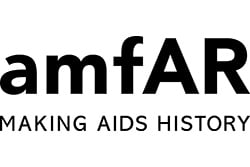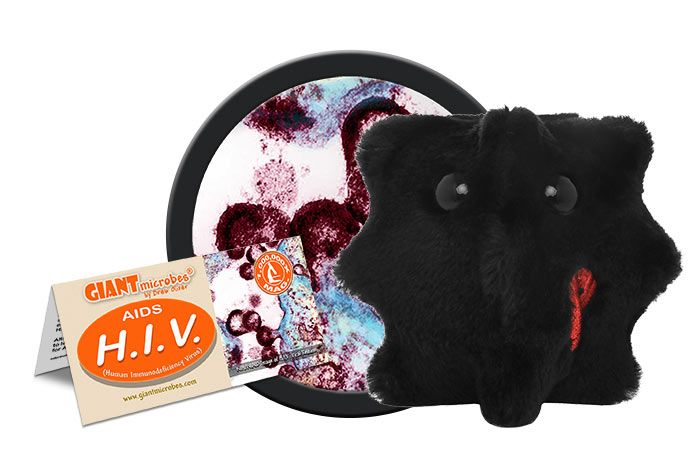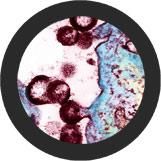HIV (Human Immunodeficiency Virus)
Our product is designed for public health education and as a useful reminder to get tested.

The Foundation for AIDS Research is a leading organization dedicated to the support of AIDS research, HIV prevention, treatment education, and advocacy. 10% of your purchase will be donated to amfAR.
Product Details
Additional Information
| Sizes | Giantmicrobes are based on actual microbes, cells, organisms and other critters, only 1,000,000 times actual size! Gigantic (GG) 16-24" XL (XL) 10-15" Original (PD) 5-8" Keychain (KC) 2-4" with clip |
|---|---|
| Materials | Plush from all new materials. Stuffed with polyester fiber fill. Surface washable: sponge with water & soap, air dry. |
| Packaging | Each plush microbe includes a printed card with fun, educational and fascinating facts about the actual microbe or cell. |
| Safety | Every product meets or exceeds U.S. and European standards for safety. For ages 3 and up. |
All about HIV (Human Immunodeficiency Virus)
H.I.V. (human immunodeficiency virus) is a virus that kills the CD4 cells, or T-helper cells, which help the body fight infections. Once the body's immune system has been compromised, a person develops AIDS (acquired immunodeficiency syndrome).
H.I.V. is found in bodily fluids, and it can be transmitted when these come into contact with an uninfected person’s broken skin or mucous membranes. The most common means of transmission by far are:
• Sexual contact with an infected person
• Sharing needles or syringes (primarily for drug injection) with someone who is infected
• During pregnancy or birth to babies of HIV-infected mothers, or through breast-feeding after birth
Although additional transmission possibilities exist – such as accidental skin puncture by infected-needles in medical settings; introduction of infected blood into a caregiver's open cut (or eyes or nose); contact with infected blood by sharing razors or toothbrushes in a household setting – they are very rare. Insect bites and contact with H.I.V.-infected sweat have also been studied, but the risks have been found to be essentially non-existent. In fact, studies have shown that simply drying H.I.V.-infected fluids reduces viral presence by 90-99%.
Although improved treatments are helping some AIDS patients lead longer, healthier lives, there is no vaccine for H.I.V. and no cure for AIDS.
Information is provided by the Center for Disease Control.
| Name | When the virus was first discovered, each research group called it by a different name. In 1987, the U.S. and France agreed to a common name for the virus, Human Immunodeficiency Virus. That’s diplomacy in action! |
|---|
| Actual Size | About 120 nanometers, that’s 400 thousand times smaller than a golf ball! |
|---|
| Where It Lives | HIV is a virus that attacks the white blood cells and impairs the immune system in humans. It spreads from person-to-person through contact with infected blood, during unprotected sex, or from pregnant mothers to their babies. |
|---|
| Symptoms | It causes fever, tiredness, headache, muscle pain, rashes, diarrhea, and swollen lymph glands. If it goes untreated, it results in Acquired Immunodeficiency Syndrome, or AIDS. People who suffer from AIDS have damaged immune systems, leaving them susceptible to infections that a healthy immune system could normally fight off. |
|---|
| Cure | Antiretroviral therapy, or ART, is a combination of drugs used to keep the virus from multiplying. |
|---|
| History |
In 1984, in the midst of an HIV epidemic, research groups from the University of California, San Francisco in the U.S. and the Pasteur Institute in Paris, France independently identified the virus. Big Outbreaks: 1979: The first known outbreak occurred in Los Angeles and New York. Recent Outbreaks: 2015: HIV outbreak occurred in Indiana County, Indiana. |
|---|
| Fascinating Facts |
Scientists believe that the virus evolved from a chimpanzee variant called simian immunodeficiency virus, or SIV, when humans became exposed to contaminated blood and meat. Thanks to medical advancements, early therapy for HIV can prevent the onset of AIDS. Former LA Lakers player, Magic Johnson, has been living with HIV for over 20 years! Famous people who died of it: 1987: Liberace, a famous pianist and entertainer from the 1950’s through 1970’s. 1992: Anthony Perkins, actor and singer known for playing Norman Bates in Psycho. 1992: Robert Reed, television actor known for his role as Mike Brady in the Brady Bunch. |
|---|












